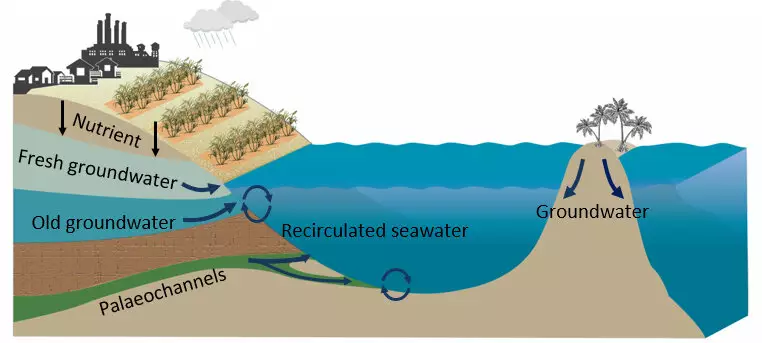The health of the Great Barrier Reef, one of the world’s most iconic natural wonders, is under threat due to previously unknown sources of nitrogen and phosphorous. In a groundbreaking study published in Environmental Science & Technology, scientists have identified submarine groundwater discharge as a significant contributor to nutrient inputs in the reef ecosystem. These findings have significant implications for the current preservation and restoration efforts being undertaken.
Unveiling the Hidden Source
The research, led by Dr. Douglas Tait from Southern Cross University, utilized natural tracers to track the movement of nutrients off the coast of Queensland. The study involved collecting data from offshore transects, rivers, and coastal bores in a vast area spanning from south of Rockhampton to north of Cairns. By analyzing radium isotopes, the scientists were able to quantify the extent to which nutrients were transported from the land and shelf sediments via submarine groundwater discharge.
A Surprising Revelation
One of the most astonishing findings of the study was the magnitude of the nutrient inputs from groundwater discharge, which were previously unaccounted for. The researchers discovered that groundwater discharge accounted for 10-15 times more nitrogen than river inputs and a staggering two-thirds of phosphorous inputs. These numbers indicate that groundwater contributes nearly twice as much nitrogen to the Great Barrier Reef as compared to river waters.
The majority of current efforts to mitigate nutrient impacts on the Reef have primarily focused on outflows from river systems. However, this study highlights the urgency to redirect our attention towards addressing the hidden threat posed by groundwater discharge. Lead author Dr. Douglas Tait emphasizes that excess nutrients can trigger harmful algal blooms, crown-of-thorns starfish outbreaks, and fish diseases that have been steadily increasing in the Reef over the past few decades. It is clear that the strategies employed thus far are insufficient to protect the ecosystem from the detrimental consequences of excessive nutrients.
Unlike nutrients carried by rivers, those present in groundwater can remain stored underground for extended periods before being discharged into coastal waters. This temporal aspect necessitates a long-term approach to research and conservation efforts. Strategies designed to safeguard the Great Barrier Reef must recognize the complex nutrient dynamics that occur within the system, taking into account the prolonged storage of nutrients in groundwater.
The discovery of the significant impact of submarine groundwater discharge on the nutrient inputs to the Great Barrier Reef marks a significant turning point in its conservation. This study highlights the urgent need for a strategic shift in management approaches to protect the reef from the detrimental effects of excessive nutrients. Preserving the health and integrity of this majestic natural wonder will require long-term strategies that address the hidden threats lurking beneath the water’s surface. As we continue to uncover the complexities of the Great Barrier Reef ecosystem, it is crucial that our efforts adapt to protect this irreplaceable treasure for future generations.


Leave a Reply